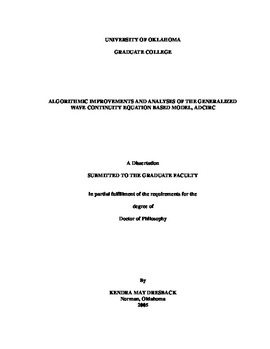| dc.contributor.advisor | Kolar, Randall L., | en_US |
| dc.contributor.author | Dresback, Kendra May. | en_US |
| dc.date.accessioned | 2013-08-16T12:20:18Z | |
| dc.date.available | 2013-08-16T12:20:18Z | |
| dc.date.issued | 2005 | en_US |
| dc.identifier.uri | https://hdl.handle.net/11244/1059 | |
| dc.description.abstract | Second, nearly all GWC-based models utilize a velocity-based, non-conservative momentum equation (NCM) to obtain the depth-averaged velocity profile. It has been hypothesized that the conservative momentum equation (CM) may improve accuracy, mass balance and stability. Results show that the CM equation improves mass balance, both globally and locally, especially in areas of steep bathymetry gradients, and improves local spatial accuracy in these same regions, yet does so without significantly impacting stability, temporal accuracy and global spatial accuracy. | en_US |
| dc.description.abstract | First, the current time marching algorithm is semi-implicit, with the nonlinear terms evaluated explicitly. It has been hypothesized that the explicit treatment of the nonlinear terms can lead to instabilities. An iterative, implicit treatment of the nonlinear terms is implemented and studied. Results show an increase in the maximum time step of at least eight-fold, depending on the domain, and an increase in temporal accuracy from first to second order. A parallel implementation of the algorithm scales as well as the original algorithm. | en_US |
| dc.description.abstract | Shallow water equations are based on conservation of mass and momentum and can be used to model the hydrodynamic behavior of oceans, coastal areas, estuaries and lakes. The model used in this research ADCIRC, an advanced three-dimensional circulation model, is based on the shallow water equations. ADCIRC provides elevation changes and velocity profiles that can be utilized by themselves or coupled with other models, such as water quality models, thus lending itself to a wide-variety of applications. Three research areas are investigated in this dissertation in an effort to improve the predictive capabilities of ADCIRC through improved numerics. | en_US |
| dc.description.abstract | Third, baroclinic models that are used to simulate density-driven flows require an accurate and stable computation of the baroclinic pressure gradient (BPG). In this study, four methods for computing the BPG are investigated, along with resolution requirements (horizontal and vertical). Numerical experiments thus far indicate that the z-coordinate method provides the least amount of error, and a hybrid method, which switches from sigma to z-coordinates at a prescribed depth, also shows promising results. | en_US |
| dc.format.extent | xxi, 228 leaves : | en_US |
| dc.subject | Hydrodynamics. | en_US |
| dc.subject | Wave equation. | en_US |
| dc.subject | Engineering, Civil. | en_US |
| dc.subject | Equations of motion. | en_US |
| dc.title | Algorithmic improvements and analyses of the generalized wave continuity equation based model, ADCIRC. | en_US |
| dc.type | Thesis | en_US |
| dc.thesis.degree | Ph.D. | en_US |
| dc.thesis.degreeDiscipline | School of Civil Engineering and Environmental Science | en_US |
| dc.note | Adviser: Randall L. Kolar. | en_US |
| dc.note | Source: Dissertation Abstracts International, Volume: 67-05, Section: B, page: 2721. | en_US |
| ou.identifier | (UMI)AAI3219702 | en_US |
| ou.group | College of Engineering::School of Civil Engineering and Environmental Science | |
